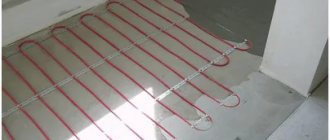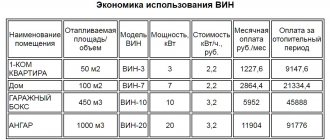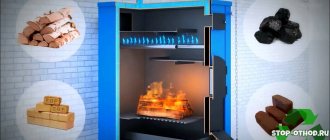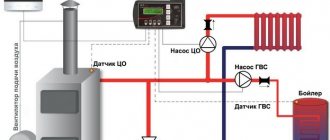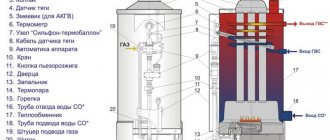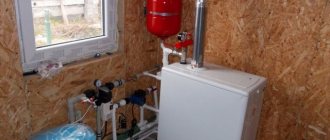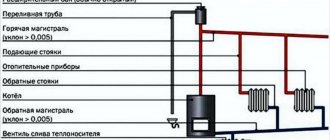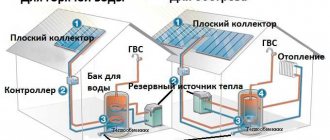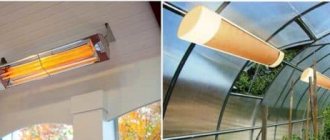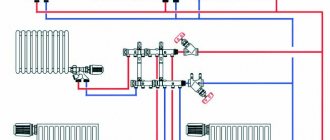An efficient, long-burning wood-burning pyrolysis boiler is considered the optimal choice in most Russian regions. The device can be installed in places where it is not possible to connect to the main gas or there are problems with a stable supply of electricity, and the raw materials used are a more affordable type of fuel (as opposed to pellets).
How did long-burning pyrolysis boilers with wood appear?
Heating units of this type are a relatively new invention. The pyrolysis process was first used in industry. They did not immediately begin to use the energy of combustible gases for domestic purposes. Only in 2000 in Vilnius, designer Edmuntas Štropaitis patented a new heating system, which became the most advanced.
It was a pyrolysis boiler, in which the combustion of fuel and the gases released from it occurs separately. Moreover, the raw materials are consumed without a trace, and there is practically no exhaust vapor in the return chimney.
Description of the operation scheme of pyrolysis boilers
A complete picture of the operation of the unit can be given by a schematic diagram of a pyrolysis boiler. First, the main firebox is loaded with fuel and ignited. In this case, the ash pan damper is open as much as possible. After the firewood starts to burn, the door begins to close, the burning process slows down and turns into smoldering. Then the intensive release of wood gas begins, which rises and enters the secondary afterburning chamber. Heated air is supplied there through many calibrated holes. The latter enters the channel from the same opening under the ash pan lid and along the way receives heat from the hot wall of the firebox.
Schematic diagram of the boiler
The entire technological process proceeds thanks to the natural draft created by the chimney, so the speed of movement of air and flue gases in the channels is low. The operating principle of a pyrolysis boiler is that in the secondary chamber, heated air enters into a thermochemical reaction with wood gases and ignites them. As a result, not only gases are burned, but also small volatile particles, making the smoke from the chimney almost invisible. In fact, pyrolysis fuel combustion is more environmentally friendly than traditional combustion, since its combustion products contain much less carbon and nitrogen oxides, as well as ash particles.
The firewood in the firebox burns more slowly than usual, so one load can be enough for 10–12 hours of operation, depending on the power of the gas generating unit and the moisture content of the wood. Setting up a pyrolysis boiler involves limiting the supply of combustion air. Too little of it will not allow the thermochemical process to begin in the secondary furnace, and too much will cause incomplete combustion of gases and a decrease in the efficiency of the unit. For a device operating on natural draft, the air flow will need to be adjusted in each individual case, since the height and diameter of the chimney pipe can vary greatly. Accordingly, the traction force will be different. In some cases, it should be increased by raising the pipe to a greater height.
If the chain drive of the ash pan lid is equipped with a thermostatic regulator, then setting the device is reduced to setting the desired coolant temperature. The thermoelement built into the water jacket of the gas generator unit acts on the chain drive depending on the water temperature and closes or opens the damper itself, regulating the combustion intensity.
Comparison of pyrolysis and solid fuel boilers
To create artificial draft that will not depend on the parameters of the chimney, pyrolysis-type boilers are additionally equipped with a blower fan and an automation kit that regulates its operation. If a conventional unit can operate with an efficiency of about 85–90%, then a blowing machine helps to develop it to 93%. There is a disadvantage here - dependence on external energy sources.
Types of equipment
Pyrolysis solid fuel boilers come in several types.
Devices are classified according to the type of raw material:
- Wood burning units. They can contain up to 20% of other solid fuel. But it is not recommended to do this constantly, since when coal burns, slag is formed, which is difficult to remove.
- Combined. Boilers can operate on coal (brown is mainly used) in combination with firewood. But stone is also used; it is possible to install a special pellet burner.
In combined models, the standard includes 2 cameras placed one above the other.
Fuel for pyrolysis boiler
Solid fuel pyrolysis boilers are practically omnivorous. Various types of solid fuel can be used as fuel: from ordinary firewood to peat.
Based on this, a boiler can be heated with any type of solid fuel, but still each type has its own inherent qualities and properties, so the operation of the boiler will also differ.
Therefore, fuel selection is a very important process.
- Using regular firewood.
Firewood for solid fuel pyrolysis boilers must be dry (it is allowed to use firewood with a moisture content of no more than 20%). The heat transfer of the boiler depends on dryness.
When loading logs into the firebox, they should be placed tightly together, and a free space of at least 20 cm should be left at the top. It is worth noting that unsplit firewood can also be used.
When loading for the first time, it is necessary to use approximately half of the portion of firewood, the rest is placed as it burns out in the boiler. Firewood burns unevenly - it must be carefully laid out on the surface of the firebox all the time, while preventing the solid fuel pyrolysis boiler from cooling.
The disadvantage of using firewood is that heating with this type of fuel cannot be automated. An advantage is the fact that this is a very environmentally friendly way of heating a room.
- Use of peat.
When using peat as fuel for a solid fuel pyrolysis boiler, certain rules must be followed. Firstly, the firebox must always be cleared of ash, and secondly, the ash door must be closed.
Peat should be placed on a grate. For better kindling, you can put some firewood on this layer and cover it all with another layer of peat. Then open the chimney valve and start lighting.
During operation of solid fuel heating equipment, it is necessary to ensure that the peat always lies in an even layer. This arrangement of peat will ensure maximum heat transfer.
- Use of coal.
To obtain the best level of heat using coal as fuel, it is necessary to use a special firebox - a shaft with a grate and vertical walls.
The firebox must be high enough, the distance between the arch and the grate must be at least 50 cm. The combustion and ash doors must be made of cast iron, the optimal distance between the doors is 21 cm.
In addition, it is recommended to strictly seal the doors. It should be remembered that when using coal, a new portion of fuel should be added only when the first one has flared up well. In this case, you need to constantly maintain an even layer and prevent the coal from burning to the grate.
- Use of fuel briquettes.
Today, fuel briquettes are the most optimal means for heating solid fuel pyrolysis boilers. You can use both coal and peat briquettes.
Thanks to the use of briquettes, you will receive high calorific value, an even combustion process (no need to interfere with the combustion process itself and adjust the layers), high density of the burning layer, a small amount of flame and a minimal amount of smoke.
Another advantage is the combustion of the briquette without any residue and the convenience of packing the briquettes. The combustion chamber of a solid fuel pyrolysis boiler is carried out until the fuel briquettes are completely burned. If unburned briquettes remain, they are reused.
The dimensions of a standard boiler firebox regulate the dimensions of the fuel used (dimensions of firewood or briquettes). As a rule, logs with a length of 400 mm and a diameter of up to 200 mm are used for fuel in gas generator boilers. The size of fuel briquettes is 300x30.
Along with firewood or briquettes, sawdust can also be used as fuel. But they should be taken no more than a third of the main part of the fuel by volume.
The operating instructions stipulate that the fuel moisture content should not be higher than 45%. The lower the moisture content of the wood, the greater the power of the boiler and the longer it can operate without repair.
For example, a kilogram of wood with 20% humidity when burned produces heat equivalent to 4 kWh, and firewood with 50% humidity produces only 2 kWh. In addition to the fact that with an increase in moisture content in the fuel, the specific heat of combustion decreases, fuel consumption increases significantly.
Construction of pyrolysis-type heating devices
Boilers with forced air supply have 2 compartments, which are located differently. Solid fuel is loaded into the first chamber. Oxygen access is metered. First, it is needed to start combustion, then it is supplied in a minimal amount to maintain the smoldering of the raw material. During the process, pyrolysis gases are released, which enter the second chamber. There they are burned and heat is released in large quantities. It is enough to heat a private home.
In boilers with forced oxygen supply, the main elements are:
- Combustion chamber for solid raw materials.
- A fan with which air is pumped (the total volume of the latter is divided into 2 streams).
- Secondary compartment for pyrolysis gases, which is located under the combustion chamber.
- A special nozzle located between the sections. It is made from a refractory composition, which in its characteristics is close to fireclay bricks.
There are boilers with natural oxygen supply. The combustion chamber is located at the bottom of the unit, and the afterburning compartment is located above it. Air enters the departments naturally through dampers. The latter help regulate the oxygen supply.
Significant disadvantages of boilers
If you visit any online store of heating units and ask how much pyrolysis heat generators cost, you will immediately see their main drawback. Not the most expensive Russian boiler “Suvorov M” K-20 (20 kW) will cost 1320 USD. e., and identical in power ATMOS DC 20 GS – 2950 cu. e. For comparison: the price of the expensive traditional heater Buderus Logano S131-22 H is 1010 USD. e.
Let us outline other disadvantages of gasifying heat sources:
- 2 chambers, a brick or ceramic lining plus a water jacket in the lower part of the body - the listed design solutions significantly increase the weight and size of the units;
- high requirements for fuel quality;
- coolant with a temperature of 80 °C is rarely used when heating private houses, which means that you cannot do without an expensive heat accumulator + piping elements;
- Ceramic lining parts do not last forever - the nozzle may crack due to overheating and will have to be replaced.
It must be said that pyrolysis boilers attract home craftsmen. But making such a unit with your own hands is very difficult; you need experience and investment in purchasing materials. It is not possible to make a heater for free. It is much easier to weld a regular or mine boiler.
Note. Judging by the reviews of boiler owners on thematic forums, it is still possible to use raw firewood. The algorithm is as follows: the unit is melted and warmed up with dry logs, then wet wood is added. But the share of such fuel should not exceed 30%, otherwise soot and soot will form. Let's listen to the expert's opinion in the video:
Specifications
Basic information about boilers with a water circuit is indicated in the documentation supplied by the manufacturer. However, there are homemade devices on the market, the parameters of which are not recorded anywhere. If you have the skills, every home owner will theoretically be able to make the equipment with their own hands if they find the appropriate material (sheet metal, fireclay brick) and temperature sensors. But the operating efficiency and safety level of the devices will be lower than that of factory products.
In pyrolysis boilers, the efficiency, compared to other models, is relatively low and amounts to 87-90%.
But at the same time, they are efficient, since the fuel burns almost completely, with a minimum amount of waste: 1 stack of firewood is enough for at least 8-12 hours.
general information
A pyrolysis boiler usually has an upper and lower chamber . The first one is loaded with fuel and combustion products, and the lower one allows gas to be collected. In this case, the gases burn and release thermal energy. The process is regulated by the fact that air is forced into the air. This is done using a fan built into the system.
The main type of fuel is firewood . They are loaded upstairs, and after that the boiler is ignited. In order to add firewood, the back wall and loading door open. After this, the wood is ignited and the process continues.
In order to fully automate the unit, it needs to be refueled 2 times a day. After it reaches temperature, the controller turns off the air in the fan. Then the supply is resumed.
If we talk about the existing types of boilers, then they include:
- Single-circuit.
- Dual-circuit.
In addition, the boiler can be made of cast iron or steel . If you are faced with choosing one type or another, then you need to consider the main advantages and disadvantages of each. It is better to look at the reviews in advance and only then make your choice.
Principle of operation
The functioning of the units is based on pyrolysis, i.e. a process occurring at a temperature of +270…+700°C. It is characterized by the release of a large amount of heat, due to which the fuel is additionally dried, which promotes its complete combustion.
Gases are released during operation. Their combustion also produces thermal energy. At the same time, they actively interact with carbon, which eliminates the formation of harmful impurities.
Subsequently, mixing oxygen with pyrolysis steam at the required temperature leads to combustion of the latter to produce thermal energy.
At the exit, the smoke contains only water vapor and carbon dioxide; emissions of carbon monoxide into the atmosphere are reduced.
Why is it better to choose a pyrolysis boiler and the basic rules for its operation
- Firstly, during the combustion of firewood it is impossible to reach such a high temperature as during the combustion of the gas obtained from them.
- Secondly, to maintain the combustion of gas, less secondary air is required than for burning wood; accordingly, the combustion temperature will be higher, and with it the efficiency.
- Thirdly, the procedure for burning pyrolysis gas is easier to control, thus, the operation of a gas generator boiler is automated in the same way as a liquid fuel or gas boiler.
This equipment is based on pyrolysis fuel combustion technology. Its essence lies in the fact that under the influence of elevated temperature and in conditions of lack of oxygen, wood begins to decompose into a solid residue and a volatile part - pyrolysis gas.
Pyrolysis occurs at temperatures ranging from 270 – 700 degrees. This process is exothermic, in other words, it is characterized by the release of heat, which increases the drying and heating of the fuel in the boiler.
Subsequently, the mixing of oxygen with pyrolysis gas at a high temperature leads to combustion of the latter, which is used to obtain thermal energy.
Pyrolysis gas actively interacts with carbon, due to which the flue gases leaving the boiler almost do not include harmful impurities, being considered, to a greater extent, a mixture of water vapor and carbon dioxide.
Numerous studies have shown that carbon dioxide will be released into the environment up to three times less than from an ordinary wood-burning and, even more so, coal-fired boiler.
The pyrolysis combustion procedure is characterized by the formation of a small amount of ash and soot, which is why this equipment rarely requires cleaning.
The advantages of long-burning pyrolysis boilers with a water circuit are environmental friendliness.
The efficiency declared by the manufacturers is only 4–10% higher than the productivity of a conventional solid fuel boiler. Obviously, the choice should be based on taking into account the individual characteristics of the heating system and the preferences of the owners.
The main features of a quality model that is worth purchasing:
- Good, neat welds and sufficient material thickness (at least 4 mm). Thin metal in cheap boilers burns out quickly and is more susceptible to corrosion. Buying such products is a bad decision!
- Ceramic nozzle and gas combustion chamber lining (this model will last longer). This material has excellent fire-resistant properties. Make sure that ceramics is used, as the most reliable material for these parts of the boiler.
- Two working chambers with the ability to smoothly adjust the air supply. Two chambers are the main feature of an effective pyrolysis model! If you need high-performance and at the same time economical long-burning boilers, choose long-burning pyrolysis boilers with a water circuit.
- The coolant is in contact only with the chimney and gas combustion chamber. If this technical point is not observed, the boiler will lose heat, since the main combustion chamber has a lower temperature (the coolant cools on contact).
- Availability of an automatic control unit and a corresponding warranty for it. Repairing this very important unit for regulating the air supply in some cases costs up to 50% of the total cost of the equipment. Take this part of the boiler seriously.
Some more tips for choosing a boiler:
- The required power can be calculated based on the area of the room and the degree of insulation. Approximately you need to take 1 kW per 10 m2, while adding a few kW, also taking into account the functions of the boiler as a boiler. So, if you have an area of 80 m2, then a 10 kW option is suitable, but if the area is 100 m2 and the walls are not insulated, then 10 kW will not be enough;
- The size of the firebox is important, if you burn with wood, the larger it is, the larger the size of firewood that can be placed there;
- Burning time without additional loading is usually indicated taking into account excellent quality fuel, so take 2/3 of these data. For example, if 10 hours are stated, you can count on 6;
- Energy independence is very important when choosing a boiler for a dacha or a place remote from electricity; in addition, it also saves electricity.
For normal operation of the equipment, it is necessary to maintain a certain range of fuel combustion temperatures. This range is from 2000 to 8000 C.
It is necessary to configure the device quite accurately. To prevent emergency situations at high temperatures, the water circuit of the unit is used.
The housing plays the role of a heat exchanger; water passes between its walls. This feature and the built-in coil in one of the walls prevents the creation of prohibitive temperatures.
When the water temperature is insufficient, the formation of pyrolysis gas stops, air is supplied to the combustion chamber and the boiler operates like a conventional solid fuel stove. It is not allowed to cool the water below a temperature below 600 C. In this case, the combustion process without oxygen stops in any type of pyrolysis boilers.
To ensure a small water circuit and transfer the equipment to an operating state, an additional jumper (bypass) is installed in the water circuit. The bypass is adjusted manually; temperature sensors are installed to control the temperature.
This type of equipment can work on all types of firewood, briquettes, pallets.
In reality, a type of fuel such as coal can be used. Provision is made for the processing of flammable household and industrial waste. But this can backfire due to their high polymer and rubber content.
Pyrolysis boilers are produced only as single-circuit boilers and cannot be used for heating water. But, in the absence of natural gas, to create comfortable conditions in the building, this type of equipment is the best solution to the problem.
Advantages and disadvantages
Boilers of this type have their advantages and disadvantages.
The main advantages include:
- the possibility of obtaining additional thermal energy, since the raw materials burn almost completely, and the gases have a high temperature;
- the absence of a large amount of soot and harmful substances, which often arise during the operation of solid fuel boilers;
- long period of work on 1 load;
- equipment power regulation.
In addition, pyrolysis is a process that is easier to automate than standard combustion. This means that it is easier to improve the safety of equipment.
Among the disadvantages, users note the high price compared to other solid fuel boilers. In addition, pyrolysis devices have a complex design and dimensions. The devices weigh 30-35% more than classic models running on gas and other types of raw materials.
Operating principle and equipment design
Pyrolysis boilers are like a home laboratory that releases gas from wood that is necessary for heating. In general, pyrolysis is widely used in industry .
We are talking about the breakdown of organic compounds into simple substances. This is possible with limited oxygen and high temperature. The pyrolysis boiler is a two-chamber equipment, in the upper part of which wood pyrolysis occurs at a temperature of 200–800˚C. As a result, it decomposes into gas and charcoal. The mixture of released gas and air enters the lower chamber, where it burns at a temperature of about 1000–1200˚C. This generates a lot of heat. In fact, in modern pyrolysis boilers, gas is burned, not wood, so the efficiency is about 95%.
Using the equipment, according to reviews from owners, is not difficult, because gas combustion is easier to control, which means the control process can be automated .
As mentioned earlier, the boiler firebox is divided into 2 chambers, between which there is a grate. In the upper part, smoldering and pyrolysis of the fuel occurs. The gas flows with air into the second chamber, where there is a fireclay nozzle. Such fireboxes are characterized by high aerodynamic resistance, because forced draft is used here.
Pyrolysis boilers are divided into several types based on the location of the combustion chamber:
- upper loading compartment - in this case, the gas after combustion of the fuel moves through the pipe and enters the lower part of the firebox, and the ash falls into the afterburning chamber, due to which it is frequently cleaned;
- lower chamber - this option is considered more preferable, because processed products immediately enter the chimney, which means that the unit will need cleaning less often, but additional costs will be required to equip the chimney.
It is worth noting that 2 types of ventilation can be used for the operation of the equipment:
- natural - needs a high chimney, which provides powerful draft;
- forced - in this case it is necessary to connect to the electrical network and have a pump system.
The duration of the boiler operation depends on the temperature, type of fuel, and the quality of the home’s thermal insulation. In any case, such pyrolysis boilers are considered more efficient in contrast to traditional solid fuel models.
Rating of the best pyrolysis boilers
High-quality units are produced by Russian and foreign manufacturers. Popular among domestic brands. The brand’s boilers are manufactured using modern technologies.
The model range includes devices with power from 10 to 60-100 kW. The equipment runs on wood, coal and briquettes. The efficiency of most units is 85-87%. The equipment warranty is provided for 2 years. All models are classified as non-volatile. Geyser VP-6 and VP-15 are suitable for domestic use.
Among the domestic equipment, floor-mounted single-circuit devices “Bourgeois-K Exclusive” are popular. They are also used in residential premises (not only utility rooms) due to their aesthetic appearance. The line includes 3 models - with a power of 12, 24 and 32 kW. They are labeled like this - for example, “Bourgeois-K Exclusive-12”.
Of the imported boilers, the German Buderus Logano S171 W series is considered the best. The model range includes appliances of varying power, which are intended for private homes and can operate independently or in conjunction with gas or electric units.
Heating with wood - pros and cons
Homemade wood boilers are actively used for heating residential premises - these are small country houses and large private households located in places far from gas mains. They use wood or coal as fuel. Coal units are distinguished by high heat generation, but it is not always possible to obtain this fuel. That's why people prefer wood-burning models.
Let's look at the main advantages of homemade wood-burning boilers:
- You do not need permission to install and operate - we have the right to independently dispose of this equipment;
- Cheap to operate – compared to electric heating, heating with wood is cheaper. And if you find a source of free logs, you will only have to spend money on assembling a heating boiler;
- Independence from electrical networks - this refers to the simplest units, which do not contain electrical components;
- The possibility of implementing long-term combustion - it will reduce the number of approaches for adding more and more portions of fuel;
- Cheap to assemble - a homemade wood-burning boiler for a private home will cost less than its factory-made counterpart.
There are also some disadvantages:
Only constant cleaning of the boiler and its systematic scheduled repairs can ensure stable and efficient operation of the unit throughout its operation.
- Homemade wood-burning boilers for heating a home may not reach maximum efficiency due to handicraft assembly errors;
- Solid fuel boilers using coal and wood require regular cleaning - that is, we can get rid of the need to frequently add fuel, but the cleaning problem cannot be dealt with. Therefore, we will have to regularly clean the equipment from soot and ash;
- Difficulty of self-installation - homemade long-burning wood-burning boilers with a water circuit may seem difficult to manufacture. And the less experience you have with tools, the more difficult the task will seem.
In addition, homemade long-burning boilers do not have normal external characteristics, although here everything depends on the skill of the assembler.
In addition to soot and coals, condensation can form in long-burning boilers - it is formed as a result of using damp firewood.
Installation Features
Considering that pyrolysis boilers are large in size, it is better to choose an appropriate room for installation of equipment. Some models, compact in size and with decorative finishes, can be installed in living rooms (provided there is sufficient space). But in most cases, it is recommended to install the devices in the basement or kitchen - just not next to the gas stove.
Standards regarding the distance to walls and other objects must be observed - at least 1 m. In addition, free access to the boiler is provided for loading fuel, inspecting the housing, repairs, etc.
Indoors, the floor and walls are finished using non-combustible materials. Concrete foundations have to be made for massive units. Additionally, high-quality ventilation and a chimney are installed.
Criterias of choice
There is no need to skimp on the quality of the boiler, since both the efficiency of the device and the safety of its operation directly depend on this.
Main selection criteria:
- Equipment power.
- Efficiency This figure for high-quality models is 87-90%. There is not much difference between them, but all other things being equal, it is better to choose a higher coefficient.
- Weight and dimensions. They influence where the device will be installed.
- The material from which the body is made. In many models, the latter is made of boiler steel - thick enough to withstand high temperatures. It is inferior in strength to cast iron, which increases the weight of the device. In addition, the steel case is better able to withstand mechanical deformation and is easier to repair. Cast iron, despite its strength, is considered a brittle metal, so simply repairing cracks will not work.
Many home owners purchase single-circuit models. They are used in conjunction with a boiler. In double-circuit systems it is difficult to provide both heating and hot water at the same time. In terms of their effectiveness, they are inferior to the first.
How to choose the right boiler power
We must assume that for a house with a ceiling height of up to 3 m, 1 kW of power is needed for every 10 sq.m of area. But this does not mean that a 15 kW device will be able to heat a room of 150 sq.m. Heat loss must be taken into account.
The latter depend on the double-glazed windows inserted into the windows, wall materials and even climatic conditions. Basically, when choosing, an additional 10-15% is included, and in regions with harsh winters - up to 20% of power. A specialist will help you make a more accurate calculation of the indicator.
